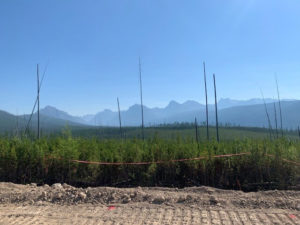
As we arrived at our campsite in Glacier National Park after a breathtaking ride over Logan Pass on the Continental Divide, I felt as though I was home. Glacier’s ecosystem is strikingly similar to that of my hometown of Breckenridge, CO. Both places are strikingly beautiful, yet prone to intense wildfires that are growing more frequent and more intense as the climate becomes hotter and drier.
On Day 25 of our trip, wildfire ecologists Phil Higuera and Tyler Hoeker joined us in Glacier and took us on a hike back in time to learn how a part of the park has responded to wildfires.
The ridge bordering Lake McDonald consists of all sorts of trees, including lodgepole pine, douglas fir, ponderosa pine, spruce and aspen, as well as our favorite shrub, the wild huckleberry. This variety of species shows the uniqueness of this particular hidden valley, which supports many species more commonly found in the Pacific Northwest.
Beyond our campsite, we saw burn marks and evidence of past wildfires. Some trees are better adapted to fire than others. Larch, douglas fir and ponderosa pine often survive low intensity fires, growing tall and dispersing their seeds far and wide.
Some trees, like lodgepole, have seeds that depend on fire to open. After a fire, they will release a vast amount of seeds, creating a dense tangle of young trees that will progressively thin out over time, like a rebirth. This process is necessary for these forests to regrow, but we have been seeing hotter, more frequent fires changing the way that they do this.
Other trees, like douglas fir, have thick bark that can fend off fire from the core of the tree, and only let a small portion of the tree die before it repairs and regrows. All of these trees have evolved to have a process for regrowth with fire over time.
In the last 100 years, we have altered the climate quickly and dramatically. Trees can adapt to change, but need thousands of years to adjust. The species that are better suited for hotter, smokier, drier fire-prone climates will prevail. This era of anthropogenic climate change is a stressful one for our forests as they attempt to endure these changes over a compressed time span.
Over the past few days, we have seen evidence of climate change impacts on large landscapes. To slow the rate of change, there is a lot to be done on both small and large scales. Average citizens have to change their habits; local, state and nationwide governments have to follow through on action; and corporate America has to hop on board as well.
While we keep on enjoying the mountain passes that we conquer to get to our beautiful destinations, have to work towards bigger leaps in the quest for climate solutions.
Ben Carlson attends Montana State University, where he is majoring in Environmental Studies.